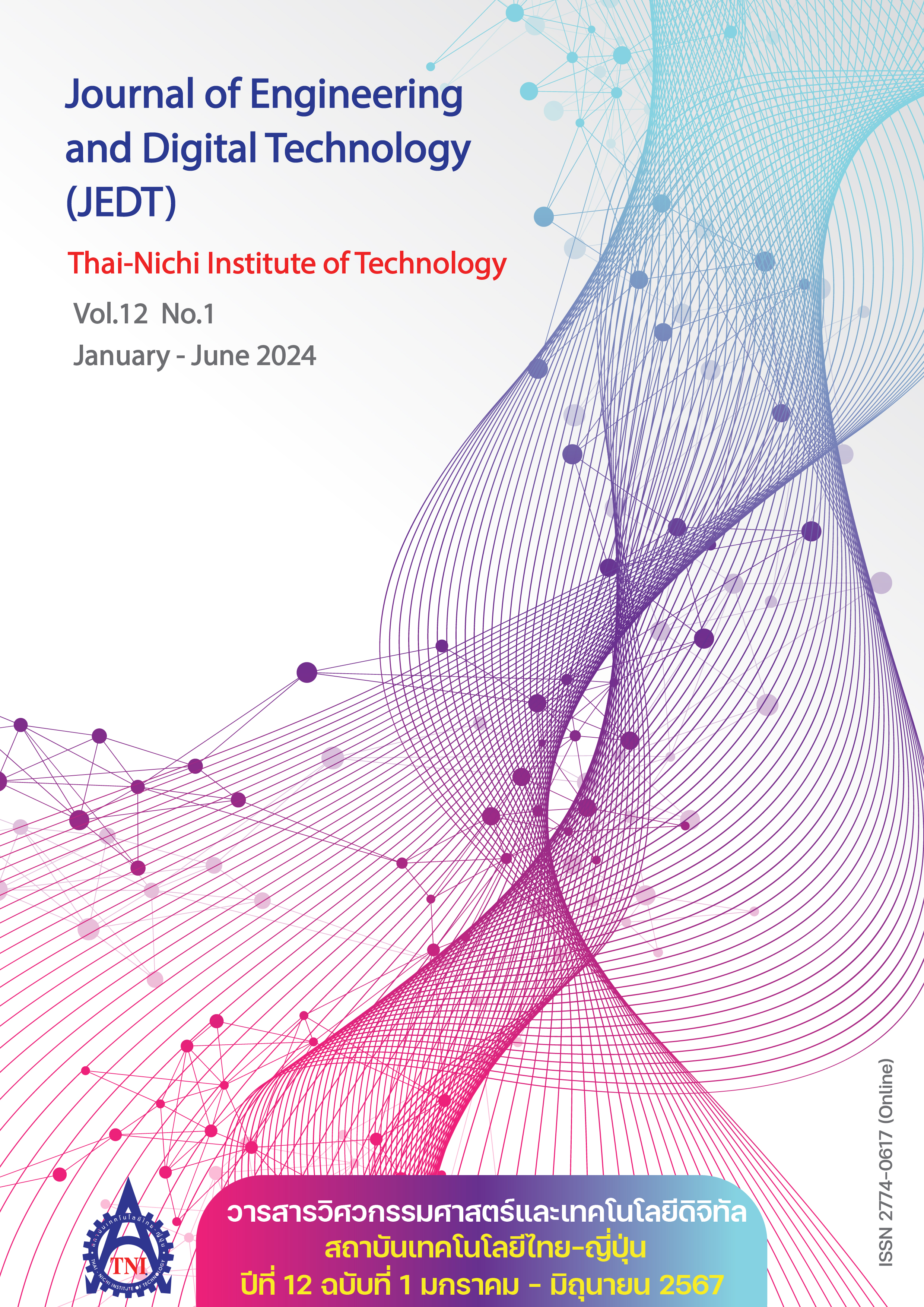Increasing of Stretch Formability on Hole-flanging Parts of Aluminum Alloys by Smooth Sheared Surface
Main Article Content
Abstract
Aluminum alloy is a lightweight material that fractures often occur during stretch forming, especially in the hole-flanging parts. However, the stretch formability of aluminum alloy increased by improving a smooth-sheared surface. The resistance of materials to edge fracture in complex shape forming is typically measured using the hole expansion ratio (HER). This paper presents the concave piercing punch design to increase smooth sheared surface which induces the increasing stretch formability of aluminum alloy. The effect of a smooth-sheared surface on stretch formability was examined via a hole expansion test (HET). The aluminum alloy grade AA1100, and AA5052 of 1.2 mm of thickness with three levels of clearance 5%t, 10%t, and 15%t were used in the experiments. The HER of aluminum alloy is influenced by a smooth sheared surface from conventional and concave piercing punch with varied clearances. In the experimental aspect, the clearance level and shape of the piercing punch, which are factors for the stretch formability of aluminum alloy, were observed by hole HER. The concave piercing punch design improves the hole expansion ratio more than a conventional piercing because a smooth sheared surface around the hole edge increases the hole expansion ratio.
Article Details

This work is licensed under a Creative Commons Attribution-NonCommercial-NoDerivatives 4.0 International License.
Article Accepting Policy
The editorial board of Thai-Nichi Institute of Technology is pleased to receive articles from lecturers and experts in the fields of engineering and technology written in Thai or English. The academic work submitted for publication must not be published in any other publication before and must not be under consideration of other journal submissions. Therefore, those interested in participating in the dissemination of work and knowledge can submit their article to the editorial board for further submission to the screening committee to consider publishing in the journal. The articles that can be published include solely research articles. Interested persons can prepare their articles by reviewing recommendations for article authors.
Copyright infringement is solely the responsibility of the author(s) of the article. Articles that have been published must be screened and reviewed for quality from qualified experts approved by the editorial board.
The text that appears within each article published in this research journal is a personal opinion of each author, nothing related to Thai-Nichi Institute of Technology, and other faculty members in the institution in any way. Responsibilities and accuracy for the content of each article are owned by each author. If there is any mistake, each author will be responsible for his/her own article(s).
The editorial board reserves the right not to bring any content, views or comments of articles in the Journal of Thai-Nichi Institute of Technology to publish before receiving permission from the authorized author(s) in writing. The published work is the copyright of the Journal of Thai-Nichi Institute of Technology.
References
G. Fang, P. Zeng, and L. Lou, “Finite element simulation of the effect of clearance on the forming quality in the blanking process,” J. Mater. Process. Technol., vol. 122, no. 2–3, pp. 249–254, Mar. 2002.
K. Mori, Y. Abe, and Y. Suzui, “Improvement of stretch flangeability of ultra high strength steel sheet by smoothing of sheared edge,” J. Mater. Process. Technol., vol. 210, no. 4, pp. 653–659, Mar. 2010.
Z. Zhou et al., “Electromagnetic cold-expansion process for circular holes in aluminum alloy sheets,” J. Mater. Process. Technol., vol. 248, pp. 49–55, Oct. 2017.
H.-S. Choi, B.-M. Kim, and D.-C. Ko “Effect of clearance and inclined angle on sheared edge and tool failure in trimming of DP980 sheet,” J. Mech. Sci. Technol., vol. 28, no. 6, pp. 2319–2328, 2014.
Z. Tekiner, M. Nalbant, and H. Gürün, “An experimental study for the effect of different clearances on burr, smooth-sheared and blanking force on aluminium sheet metal,” Mater. Des., vol. 27, no. 10, pp. 1134–1138, 2006.
M. Sasada and T. Togashi, “Measurement of rollover in double-sided shearing using image processing and influence of clearance,” Procedia Eng., vol. 81, pp. 1139–1144, 2014.
A. A. Kamarul Adnan, S. N. Azinee, N. Norsilawati, and K. A. M. Izzul, “Analysis of the influence of the blanking clearance size to the burr development on the sheet of mild steel, brass and aluminium in blanking process,” J. Achiev. Mater. Manuf. Eng., vol. 111, no. 1, pp. 26–32, Mar. 2022.
K. Lawanwong and P. Leetrakul, “FE simulations and experimental analysis of the blade angle effect on sheared surface in trimming process of advanced high-strength steel sheet,” Arab. J. Sci. Eng., vol. 44, pp. 7909–7918, 2019.
C. Won, W. Lee, H. Lee, Y. Kang, and J. Yoon, “Effect of two-stage press blanking on edge stretchability with third-generation advanced high-strength steels,” Int J. Adv. Manuf. Technol., vol. 110, pp. 13–27, Aug. 2020.
S. Park et al., “A dual-scale FE simulation of hole expansion test considering pre-damage from punching process,” Int. J. Solids Struct., vol. 236–237, Feb. 2022, Art. no. 111312.
K. Prasad, A. S. Ebrahim, H. Krishnaswamy, U. Chakkingal, and D. K. Banerjee, “Evaluation of hole expansion formability of high strength AA7075 alloy under varying temper conditions,” IOP Conf. Ser.: Mater. Sci. Eng., 2022, Art. no. 012038, doi: 10.1088/1757-899X/1238/1/012038.
B. M. Hance, R. J. Comstock, and D. K. Scherrer, “The influence of edge preparation method on the hole expansion performance of automotive sheet steels,” SAE Tech. Paper, 2013, doi: 10.4271/2013-01-1167.
S. K. Paul, “Fundamental aspect of stretch-flangeability of sheet metals,” Proc. Inst. Mech. Eng. B, vol. 233, no. 10, 2019, doi: 10.1177/0954405418815370.
A. Karelova, C. Krempaszky, E. Werner, P. Tsipouridis, T. Hebesberger, and A. Pichler, “Hole expansion of dual-phase and complex-phase AHS steels – effect of edge conditions,” Steel. Res. Int., vol. 80, no. 1, pp. 71–77, Jan. 2009.
D. J. Branagan, A. E. Frerichs, B. E. Meacham, S. Cheng, and A. V. Sergueeva, “New mechanisms governing local formability in 3rd generation AHSS,” SAE Tech. Paper, 2017, doi: 10.4271/2017-01-1704.
Metallic materials — Method of hole expanding test, ISO/TS 16630:2009, 2009.


